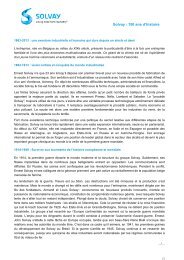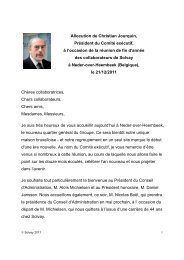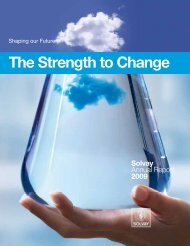Financial Statements - Solvay
Financial Statements - Solvay
Financial Statements - Solvay
You also want an ePaper? Increase the reach of your titles
YUMPU automatically turns print PDFs into web optimized ePapers that Google loves.
100<br />
<strong>Solvay</strong> Global Annual Report 2008<br />
(31) Derivative fi nancial instruments<br />
The <strong>Solvay</strong> group uses derivatives to hedge clearly identifi ed foreign exchange and interest rate risks (hedging<br />
instruments). However, the required criteria to apply hedge accounting according to IFRS are not met in all cases.<br />
This means that this form of accounting is not always applicable when the Group covers its economic risks.<br />
The Group’s exchange risk hedging policy is based essentially on the principles of fi nancing its activities in local currency,<br />
systematically hedging transactional exchange risk at the time of invoicing (risks which are certain) and monitoring and<br />
hedging where appropriate exchange rate positions generated by the Group’s activities, based on expected cash fl ows.<br />
Currency translation differences<br />
Exchange rate fl uctuations, particularly of the US dollar, can affect earnings. In the course of 2008 the EUR / USD<br />
exchange rate moved from 1.4721 at the start of January to 1.3917 at the end of December. The average rate in 2008<br />
(1.4708) compared to the average rate in 2007 (1.3706) clearly shows a weaker USD in 2008.<br />
Managing the exchange risk on debt<br />
Group borrowings are generally carried out by the Group’s fi nancial companies, which make the proceeds of<br />
these borrowings available to the operating entities.<br />
The choice of borrowing currency depends essentially on the opportunities offered by the various markets. This means<br />
that the selected currency is not necessarily that of the country in which the funds will be invested. Nonetheless, operating<br />
entities are fi nanced in their own local currencies, with this currency being obtained, where appropriate, by currency<br />
swaps against the currency held by the fi nancing company. The cost of these currency swaps is included under the cost<br />
of borrowing. These enable us to limit the exchange risk both in the fi nancial company and in the company fi nally using<br />
the funds.<br />
In emerging countries it is not always possible to borrow in local currency, either because local fi nancial markets are too<br />
narrow and funds are not available, or because the fi nancial conditions are too onerous. In such a situation the Group<br />
has to borrow in a different currency. Nonetheless the Group has taken advantage of any opportunities to refi nance<br />
its borrowing in emerging countries with local currency debt. In this way, at the end of 2008, the Group had a very limited<br />
foreign exchange exposure on its residual currency borrowings in Bulgaria.<br />
Managing the translation exchange risk<br />
The translation exchange risk is the risk affecting the Group’s consolidated accounts related to subsidiaries operating in<br />
a currency other than the EUR (the Group’s functional currency).<br />
a) Currency translation risk in the income statement<br />
For the <strong>Solvay</strong> group, this risk relates mainly to the translation into EUR of earnings generated in the NAFTA region. Based<br />
on the expected net earnings in the NAFTA region for the period in question and depending on market conditions, steps<br />
may be taken to hedge this translation risk.<br />
During 2008, the <strong>Solvay</strong> group did not hedge the income statement currency translation risk.


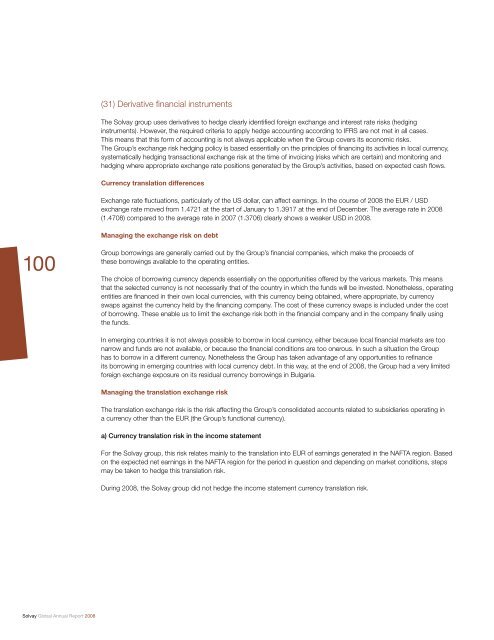

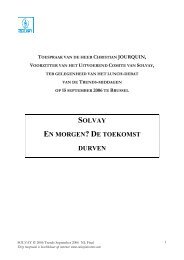
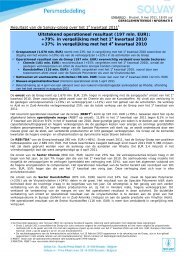

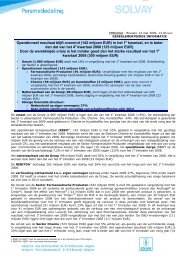
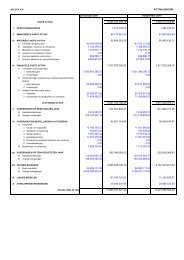


![PROC.1 [LETTRE] - Solvay](https://img.yumpu.com/16585746/1/184x260/proc1-lettre-solvay.jpg?quality=85)
